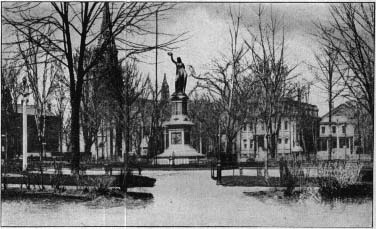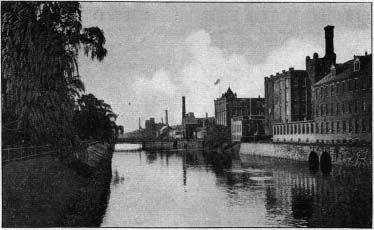|
Sketch of Holyoke by George H. Allyn, page 12 Many people still remember Jeff Manning, a gigantic Ward Four character of the 1870 to 1880, decade. Jeff was mild as milk when sober but the red eye transformed him into a bull moose, requiring on an average about three stalwart policemen to subdue him. Last heard of, he was in the navy. Maurice D. Fenton was generally regarded as about the most fearless police officer the city had, and his tragic death in 1895 caused deep regret. The decade of 1870 to 1880 changed the medical and legal list radically. Very early in the 70's T.B. O'Donnell was admitted to the bar and came to Holyoke from Northampton, being the present dean of the profession in active practice, Judge Chapin having withdrawn from the heat of the combat. From the very first Mr. O'Donnell ranked high in legal attainments, and his integrity in his profession was like that of Watson Ely's in his calling, absolute and unassailable. Just about the same time H. L. Sherman, Esq., came here, and he and Mr. O'Donnell later formed a partnership, continuing till the early 80's. Judge Sherman, as the boys loved to call him, was a unique character, a man of sincerity, truth and utter fearlessness. An ardent republican, he was selected as one of the disputants in a Lyceum debate as to whether Hayes or Tilden was lawfully elected in 1876. He was assigned to the Tilden side, and, after examining the evidence so as to put up a good argument, he became convinced that the democratic candidate had the right of the matter, and after that nothing could shake him in his position. William H. Brooks, H.K. Hawes, James J. Reardon, A.A. Tyler, 0.E. Genest, R.G. Kilduff, Jonathan Allen, F.A. Beals, and William Slattery all came in between 1872 and 1882.
 Soldier's Monument, Hampden Park.
In the late 60's Dr. J.J. O'Connor and Dr. George H. Smith began their long and honorable practice. In the late 60's also (about 1869) came Drs. Blodgett, Draper, Tuttle, and J.U. Woods, and in 1871 Dr. G.W. Davis. Dr. D.H. Donoghue was of a younger school, starting in about the end of the decade. R.0. Dwight and Dr. Cox were prominent in law and medicine, but were South Hadley Falls citizens. Dr. M.M. Mitivier settled here in the early 70's, and practiced extensively till 1892. Drs. Taylor and Murlless had come in as dentists in the late 60's, and D.G. Harkins in the early 70's. Some of the characters of this decade were Deacon A.H. Childs the coal dealer; J.W. Davis (commonly known as "Jake" Davis), ice dealer, and E.D. Shelley, blacksmith. They were typical New Englanders. Deacon Childs was usually short of money, and was apt to be collecting to "pay a note." One day he dunned a man who was well able to pay, but nearly a dead beat in practice. "I have got to pay a note," said the good deacon. "They're bad things, Deacon; you shouldn't give them," said the debtor, and passed on. W.H.H. Ward was a pioneer baker at the corner of High and John streets, first as Wedge & Ward, and E.J. Pomeroy succeeded his father-in-law, E.W. Loomis in the book and variety business. D.B. Wing held forth in the stove business, and Chase Brothers were druggists at the northeast corner of Dwight and Race streets. F.P. Goodall, J.O. Wild, and J.J. Nugent were also prominent druggists. C.L. Duclos also had a drug store, and was a member of the Holyoke Rifle Club, the only surviving member of which, so far as we know, is D.H. Smith, dentist. Moore & Glover (Philander Moore, senior member) began the decade in the grocery business, and J.H. Fitzsimmons was a groceryman at the end of it. George M. Wolcott contested the shoe supremacy with C.A. Corser, being succeeded by E.F. Osborn. The Mechanics Savings bank had been organized in 1872, and of the original officers only James H. Newton, B.C. Brainard, Stephen Holman, and E.W. Chapin survive. J.G. Mackintosh & Co. were "on deck" in 1876, and the City National Bank in 1879.
 Second Level Canal, from Dwight Street.
It is difficult to enumerate the various industries that had come in, but the Wauregan Paper Company and Massachusetts Screw Company, and Newton and Ramage Paper Company were all initiated by the Newton brothers. The Beebe & Holbrook and George R. Dickinson paper mills were important additions. Speaking of the late Judge Sherman's absolute sincerity it is recalled that at the death of a local member of the bar another attorney called at a brother lawyer's office and found Squire Sherman there. The first attorney broached the idea of a bar meeting in commemoration of the deceased, and noting that the response was not particularly enthusiastic, remarked: "Blank had some good qualities." The second attorney looked at Sherman, who was meditatively gazing at the ceiling. "Well, what do you say, Sherman?" "I vow," said Sherman, "I was trying to remember what they were." Judge Pearsons was a man of remarkable brain power and ability but of a sluggish disposition, which held him back from his real place in the world. He was inclined to be easy in every sense of the word, though he could be stern if necessary. At one time the caretaker of his property reported that a certain woman must be evicted, for she wouldn't pay a cent. "Does she pay anybody?" inquired the judge. "No; she don't pay a soul." "Well, then, let her stay; she might as well bear me as anyone else." Holyoke's early fame as a baseball town deserves notice. In the early 70's the Sharps and Shamrocks fielded about as keenly as the best professionals of today, and all Holyoke turned out at their contests. When the Sharps were defeated by the Sure Pops of Ware, in 1875, it was regarded as worse than a national calamity. It is a remarkable fact that the first occasion of death decimating the ranks of the old Sharps came last year in the death of Thomas O'Keefe, the shortstop. T.M. Cleary and Dan O'Neil, catchers; "Ownie" Clark, pitcher; James 0. Leary, "Moss" Lynch, "Pomp" Moore, Hartnett, Brennan, and McCarthy "still live." Many of the Shamrocks have passed on, but and big "Wait" Sullivan still survive in our midst. In the latter part of 1878 and in 1879, Holyoke had, we believe, as good a baseball nine as there was in the country. Smiling Mickey Welch, Roger Connor, and Pat Gillespie, afterwards famous with the New York Giants; James Roseman, later star fielder of the New York Metropolitans; Powell, afterwards with the Detroits, and last but not least, R.C. Winchester, made a hard-hitting combination that was unsurpassed. Jerry Dorgan, the catcher, could throw down to second without straightening up, or moving in his tracks, and the ball raised no more than a rifle bullet. In a game with the champion Bostons in 1878, Jerry threw out four men in quick succession, Winchester touching them standing up before they got near enough to slide, and not a base was stolen on him during the game. Holyoke stole many bases on Snyder, the great Boston catcher. Springfield howled then, as now about unfairness, for in a 1 to 0 game, won by Holyoke in 1879, the Republican report said: "It is claimed that Welch's delivery was wholly illegal and unfair." W.S. Loomis became associated with E.L. Kirtland (who had bought an interest in the Transcript in 1871), buying out C.H. Lyman's interest in 1873, and obtaining control in 1875. Mr. Loomis was a snappy and forceful editor; the paper was always worth reading, and when, after selling an interest to W.G. Dwight, in the early 90's he retired in 1887, Holyoke suffered a distinct loss. For a time during the 70's the Independent Journal was published by Fordyce R. Norton, and the Holyoke News under W.H. Phillips had a brief run in 1878—cut the Transcript was the vade mecum of Holyoke. Many were the controversies thrashed out in it, the writer remembering one in particular, a bitter disagreement between the board of water commissioners and the Farr Alpaca Company in the late 70's over the extra use of water. W.S. Loomis and C.W. Ranlet also had a scrap over a printing bill that would almost have drawn tears of joy from a mud turtle.
| Previous Page | Next Page |
| People & Organizations | Allyn's Sketch of Holyoke |
| Selected Advertisments | Churches | Surname Index |
© Laurel O'Donnell 1996 - 2005, all rights reserved
This document may be downloaded for personal non-commercial use only and should not be reproduced or distributed without permission. |